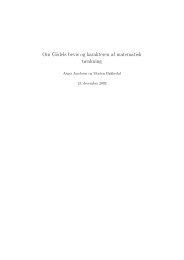Master Dissertation
Master Dissertation
Master Dissertation
Create successful ePaper yourself
Turn your PDF publications into a flip-book with our unique Google optimized e-Paper software.
Chapter 1<br />
Introductory Theory<br />
1.1 Notation<br />
I will mostly adopt the notation used in [4], but for convenience there will be<br />
some differences in the notation of a distribution. Whereas we in [4] used to<br />
write a distribution u acting on a test-function φ in the functional manner<br />
u(φ) I will in this project use the “inner product” notation 〈u, φ〉.<br />
Also note that I will use the definition of the fourier transform found in<br />
[4] rather than the one found in [6]. This will only result in some differences<br />
in the factors.<br />
I will occasionally use Einstein notation along with the convention that<br />
indices from the Greek alphabet take the values 0, 1, 2, 3 and indices from<br />
the Latin alphabet take the values 1, 2, 3.<br />
By a t-dependent operator O(t) : E → F we mean an indexed family of<br />
operators {O(t)}t∈R all from E to F .<br />
Given a t-dependent operator O(t) : E → F . We write O = s- limt→∞ O(t)<br />
if it converges in the strong operator topology to an operator O. That is, if<br />
Oφ = lim<br />
t→∞ (O(t)φ) for all φ ∈ E.<br />
Beware of the many meanings of the symbol δ. Usually it means the<br />
Dirac delta-distribution, but it is also used as a small real, the Kronecker<br />
symbol δi,j and the diagonal map. It should be transparent from the context<br />
which meaning the symbol has.<br />
For convenience I have listed some general notation on the next page:<br />
6



